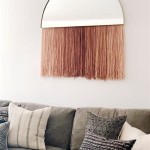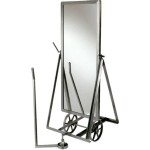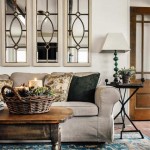Best Places to Hang a Large Mirror: Optimizing Space and Light
The strategic placement of a large mirror can significantly enhance the aesthetic and functional aspects of a room. More than a mere reflective surface, a large mirror can act as a focal point, amplify natural light, create the illusion of spaciousness, and complement existing décor. Careful consideration must be given to various factors, including room size, lighting conditions, existing architectural features, and the mirror's shape and style, to determine the optimal placement for maximum impact.
Before embarking on the installation process, a thorough understanding of the room's dynamics is crucial. This includes assessing the natural light sources, identifying areas that feel cramped or dark, and considering the existing furniture arrangement. A well-placed large mirror can correct spatial imbalances and create a more harmonious and inviting environment.
Maximizing Natural Light and Room Illumination
One of the primary benefits of incorporating a large mirror into a room is its ability to reflect and amplify natural light. Strategic placement near a window can effectively double the amount of light entering the space, reducing the need for artificial lighting and creating a brighter, more cheerful ambiance. This is particularly beneficial in rooms with limited or small windows.
The orientation of the mirror in relation to the window is paramount. Ideally, the mirror should be positioned to directly reflect the incoming light back into the room. An angled placement can also be effective, dispersing the light across a wider area. Experimentation with different angles and positions is recommended to determine the optimal configuration for maximizing light reflection.
Consider the external surroundings visible through the window. If the window offers a pleasant view of greenery or open sky, reflecting this view in the mirror can enhance the sense of connection to the outdoors and create a more tranquil atmosphere. Conversely, if the window overlooks an undesirable view, alternative placement options should be explored to avoid amplifying this visual distraction.
In rooms with limited natural light, the strategic placement of a large mirror near artificial light sources can also be beneficial. Positioning a mirror behind a lamp or sconce can create a more diffused and ambient lighting effect, reducing harsh shadows and creating a warmer, more inviting atmosphere. The distance between the mirror and the light source should be carefully considered to avoid creating glare or excessive reflections.
The type of mirror finish can also influence its light-reflecting properties. Clear glass mirrors typically offer the most accurate reflection, while tinted or antiqued mirrors may provide a softer, more diffused reflection. The choice of finish should be based on the desired aesthetic effect and the overall lighting scheme of the room.
Creating the Illusion of Space
Large mirrors are particularly effective at creating the illusion of spaciousness, making them an ideal solution for smaller rooms or areas that feel cramped. By reflecting the existing space, a large mirror effectively doubles the perceived size of the room, creating a more open and airy feel.
The placement of the mirror in relation to the room's focal point is crucial for maximizing this effect. Placing a large mirror on a wall opposite a prominent feature, such as a fireplace or a large piece of furniture, can effectively draw the eye and create a sense of depth. This technique is particularly effective in narrow hallways or rectangular rooms.
Full-length mirrors are especially effective at creating the illusion of height. By reflecting the entire vertical space, they can visually elongate the walls and make the room feel taller. This is particularly beneficial in rooms with low ceilings.
Consider the surrounding décor when placing a large mirror to create the illusion of space. Avoid placing the mirror in front of cluttered or visually busy areas, as this will only amplify the sense of chaos and detract from the overall effect. Instead, opt for placement in front of clean, uncluttered spaces to maximize the sense of openness and tranquility.
The size and shape of the mirror can also influence its space-enhancing capabilities. Larger mirrors generally create a more dramatic effect, while rectangular or square mirrors tend to be more versatile and can be easily integrated into various room layouts. Round or oval mirrors can soften the sharp lines of a room and create a more curvilinear effect.
Complementing Décor and Architectural Features
Beyond their functional benefits, large mirrors can also serve as decorative elements that complement the existing décor and enhance the architectural features of a room. The style and finish of the mirror should be carefully chosen to align with the overall aesthetic of the space.
In rooms with a modern or minimalist design, a large, frameless mirror can create a sleek and seamless look. The clean lines and absence of ornamentation can enhance the sense of simplicity and sophistication. Conversely, in rooms with a more traditional or ornate design, a framed mirror with a decorative finish can add a touch of elegance and grandeur.
Consider the color palette of the room when selecting a mirror frame. A frame that complements the existing wall color or furniture finishes can create a cohesive and harmonious look. Alternatively, a frame that contrasts with the surrounding colors can add a pop of visual interest and create a focal point.
Mirrors can also be used to highlight specific architectural features, such as crown molding, wainscoting, or fireplaces. Placing a mirror strategically to reflect these features can draw attention to their detail and enhance their visual impact. This technique is particularly effective in rooms with unique or historical architectural elements.
The shape and size of the mirror should be carefully considered in relation to the surrounding furniture and décor. A large, rectangular mirror can be used to balance a long sofa or console table, while a round mirror can soften the sharp lines of a square or rectangular room. The placement of the mirror should be deliberate and visually balanced, avoiding a sense of asymmetry or imbalance.
Finally, consider the overall theme or style of the room when selecting a mirror. A rustic or farmhouse-style room might benefit from a mirror with a distressed wood frame, while a coastal-themed room might be enhanced by a mirror with a sea-inspired design. The mirror should seamlessly integrate into the overall aesthetic and contribute to the overall sense of cohesion and style.
The height at which a large mirror is hung also warrants careful consideration. In general, the center of the mirror should be at eye level for the average person. This ensures that the reflection is clear and unobstructed. However, the optimal height may vary depending on the specific room layout and the surrounding furniture. Experimentation with different heights is recommended to determine the most visually appealing and functional placement.
The installation process for a large mirror should be approached with caution and precision. Due to their weight and size, large mirrors require secure mounting to prevent accidents or damage. Professional installation is often recommended, particularly for heavier or more complex mirrors. Proper anchoring and support are essential to ensure the mirror remains securely in place.
In bathrooms, the placement of a large mirror above the vanity can significantly enhance the functionality and aesthetic of the space. A large mirror can provide ample reflection for grooming and personal care, while also creating the illusion of a larger and more spacious bathroom. The mirror should be positioned to align with the vanity and provide adequate clearance for plumbing fixtures and lighting.
In entryways, a large mirror can serve as a welcoming focal point and provide a convenient spot for checking one's appearance before leaving the house. Placing a mirror near the entrance can also help to brighten the space and create a more inviting atmosphere. The mirror should be positioned to avoid reflecting direct sunlight, which can create glare and discomfort.
In dining rooms, a large mirror can add a touch of elegance and sophistication to the space. Placing a mirror on a wall facing the dining table can create a more formal and inviting atmosphere. The mirror should be positioned to reflect the table setting and the surrounding décor, enhancing the overall dining experience.
Careful consideration of all these factors will lead to the optimal placement of a large mirror, transforming the room into a brighter, more spacious, and aesthetically pleasing environment.

How To Hang A Large Or Heavy Mirror

Where To Hang A Full Length Mirror Seriously Happy Homes

The Best And Worst Places To Hang Mirrors In Your Home American Art Decor Americanartdecor Com

Best Places To Hang A Mirror In Your Home Frame Up Studios

How To Hang A Heavy Mirror With French Cleat
How To Hang A 100 Pound Mirror On Drywall Quora

How To Hang A Large Wall Mirror Step By Tutorial

How To Hang A Heavy Mirror Or Picture True Value

How To Hang A Very Heavy Picture Or Mirror The Best

How To Hang A Heavy Mirror With Pictures Wikihow








